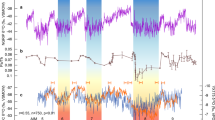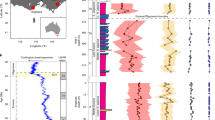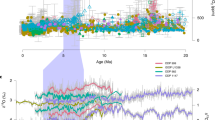Abstract
An abrupt climate warming of 5 to 10 °C during the Palaeocene/Eocene boundary thermal maximum (PETM) 55 Myr ago is linked to the catastrophic release of ∼1,050–2,100 Gt of carbon from sea-floor methane hydrate reservoirs1. Although atmospheric methane, and the carbon dioxide derived from its oxidation, probably contributed to PETM warming, neither the magnitude nor the timing of the climate change is consistent with direct greenhouse forcing by the carbon derived from methane hydrate. Here we demonstrate significant differences between marine2,3 and terrestrial4,5,6 carbon isotope records spanning the PETM. We use models of key carbon cycle processes7,8,9 to identify the cause of these differences. Our results provide evidence for a previously unrecognized discrete shift in the state of the climate system during the PETM, characterized by large increases in mid-latitude tropospheric humidity and enhanced cycling of carbon through terrestrial ecosystems. A more humid atmosphere helps to explain PETM temperatures, but the ultimate mechanisms underlying the shift remain unknown.
This is a preview of subscription content, access via your institution
Access options
Subscribe to this journal
Receive 51 print issues and online access
$199.00 per year
only $3.90 per issue
Buy this article
- Purchase on Springer Link
- Instant access to full article PDF
Prices may be subject to local taxes which are calculated during checkout



Similar content being viewed by others
References
Dickens, G. R., Castillo, M. M. & Walker, J. C. G. A blast of gas in the latest Paleocene; simulating first-order effects of massive dissociation of oceanic methane hydrate. Geology 25, 259–262 (1997)
Kennett, J. P. & Stott, L. D. Abrupt deep-sea warming, palaeoceanographic changes and benthic extinctions at the end of the Palaeocene. Nature 353, 225–229 (1991)
Zachos, J. C. et al. A transient rise in tropical sea surface temperature during the Paleocene-Eocene thermal maximum. Science 302, 1551–1554 (2003)
Bowen, G. J. et al. in Paleocene-Eocene Stratigraphy and Biotic Change in the Bighorn and Clarks Fork Basins, Wyoming (ed. Gingerich, P. D.) 73–88 (Univ. of Michigan Museum of Paleontology, Ann Arbor, Michigan, 2001)
Bowen, G. J. et al. Mammalian dispersal at the Paleocene/Eocene boundary. Science 295, 2062–2065 (2002)
Schmitz, B. & Pujalte, V. Sea-level, humidity, and land-erosion records across the initial Eocene thermal maximum from a continental-marine transect in northern Spain. Geology 31, 689–692 (2003)
Farquhar, G. D., Ehleringer, J. R. & Hubrick, K. T. Carbon isotope discrimination and photosynthesis. Annu. Rev. Plant Physiol. Plant Mol. Biol. 40, 503–537 (1989)
Spero, H. J., Bijma, J., Lea, D. W. & Bemis, B. E. Effect of seawater carbonate concentration on foraminiferal carbon and oxygen isotopes. Nature 390, 497–500 (1997)
Bowen, G. J. & Beerling, D. J. An integrated model for soil organic carbon and CO2: implications for paleosol carbonate pCO2 paleobarometry. Glob. Biogeochem. Cycles 18, doi:10.1029/2003GB002117 (2004)
Magioncalda, R., Dupuis, C., Smith, T., Steurbaut, E. & Gingerich, P. D. Paleocene-Eocene carbon isotope excursion in organic carbon and pedogenic carbonate: Direct comparision in a continental stratigraphic section. Geology 32, 553–556 (2004)
Schmidt, G. A. & Shindell, D. T. Atmospheric composition, radiative forcing, and climate change as a consequence of a massive methane release from gas hydrates. Paleoceanography 18, doi:10.1029/2002PA000757 (2003)
Renssen, H., Beets, C. J., Fichefet, T., Goosse, H. & Kroon, D. Modeling the climate response to a massive methane release from gas hydrates. Paleoceanography 19, doi:10.1029/2003PA000968 (2004)
Farley, K. A. & Eltgroth, S. F. An alternative age model for the Paleocene-Eocene thermal maximum using extraterrestrial He-3. Earth Planet. Sci. Lett. 208, 135–148 (2003)
Fricke, H. C. & Wing, S. L. Oxygen isotope and paleobotanical estimates of temperature and δ18O - latitude gradients over North America during the Early Eocene. Am. J. Sci. 304, 612–635 (2004)
Friedman, I. & O'Neil, J. R. in Compilation of Stable Isotope Fractionation Factors of Geochemical Interest (ed. Fleischer, M.) 1–12 (US Geological Survey, Reston, Virginia, 1977)
Kurtz, A. C., Kump, L. R., Arthur, M. A., Zachos, J. C. & Paytan, A. Early Cenozoic decoupling of the global carbon and sulfur cycles. Paleoceanography 18, doi:10.1029/2003PA000908 (2003)
Svensen, H. et al. Release of methane from a volcanic basin as a mechanism for initial Eocene global warming. Nature 429, 542–545 (2004)
Schäfer, K. V. R. et al. Exposure to an enriched CO2 atmosphere alters carbon assimilation and allocation in a pine forest ecosystem. Glob. Change Biol. 9, 1378–1400 (2003)
Macdonald, N. W., Zak, D. R. & Pregitzer, K. S. Temperature effects on kinetics of microbial respiration and net nitrogen and sulfur mineralization. Soil Sci. Soc. Am. J. 59, 233–240 (1995)
Cerling, T. E. The stable isotopic composition of modern soil carbonate and its relationship to climate. Earth Planet. Sci. Lett. 71, 229–240 (1984)
Bolle, M. P. & Adatte, T. Palaeocene-early Eocene climatic evolution in the Tethyan realm; clay mineral evidence. Clay Miner. 36, 249–261 (2001)
Gröcke, D. R., Hesselbo, S. P. & Jenkyns, H. C. Carbon-isotope composition of Lower Cretaceous fossil wood: ocean-atmosphere chemistry and relation to sea-level change. Geology 27, 155–158 (1999)
Hesselbo, S. P. et al. Massive dissociation of gas hydrate during a Jurassic oceanic anoxic event. Nature 406, 392–395 (2000)
Tu, T. T. N., Kürschner, W. M., Schouten, S. & Van Bergen, P. F. Leaf carbon isotope composition of fossil and extant oaks grown under differing atmospheric CO2 levels. Palaeogeogr. Palaeoclimatol. Palaeoecol. 212, 199–213 (2004)
Farquhar, G. D., von Caemmerer, S. & Berry, J. A. A biochemical model of photosynthetic CO2 assimilation in leaves of C3 species. Planta 149, 78–90 (1980)
Leuning, R. A critical appraisal of a combined stomatal-photosynthesis model for C3 plants. Plant Cell Environ. 18, 339–355 (1995)
Granier, A., Biron, P., Bréda, N., Pontallier, J. Y. & Saugier, B. Transpiration of trees and forest stands: short-term and long-term monitoring using sapflow methods. Glob. Change Biol. 2, 265–274 (1996)
Beerling, D. J. & Quick, W. P. A new technique for estimating rates of carboxylation and electron transport in leaves of C-3 plants for use in dynamic global vegetation models. Glob. Change Biol. 1, 289–294 (1995)
Sewall, J. O., Sloan, L. C., Huber, M. & Wing, S. Climate sensitivity to changes in land surface characteristics. Glob. Planet. Change 26, 445–465 (2000)
Koch, P. L., Zachos, J. C. & Dettman, D. L. Stable isotope stratigraphy and paleoclimatology of the Paleogene Bighorn Basin (Wyoming, USA). Palaeogeogr. Palaeoclimatol. Palaeoecol. 115, 61–89 (1995)
Acknowledgements
We thank W. Cheng, G. Dickens, D. Schrag, L. Sloan and F. I. Woodward for comments. Funding was provided by a National Science Foundation Biocomplexity grant. G.J.B. was supported by the National Science Foundation Graduate Research Fellowship Program, and D.J.B. gratefully acknowledges funding from the Royal Society and the Leverhulme Trust.
Author information
Authors and Affiliations
Corresponding author
Ethics declarations
Competing interests
The authors declare that they have no competing financial interests.
Supplementary information
Supplementary Notes
Contains Supplementary Methods and calculations. (PDF 134 kb)
Supplementary Table 1
Contains Supplementary Table summarizing the results of mass balance calculations of the PETM carbonate ion effect. (PDF 47 kb)
Supplementary Table 2
Contains Supplementary Table summarizing the results of paleosol organic carbon concentration measurements. (PDF 51 kb)
Rights and permissions
About this article
Cite this article
Bowen, G., Beerling, D., Koch, P. et al. A humid climate state during the Palaeocene/Eocene thermal maximum. Nature 432, 495–499 (2004). https://doi.org/10.1038/nature03115
Received:
Accepted:
Issue Date:
DOI: https://doi.org/10.1038/nature03115
This article is cited by
-
Middle Miocene long-term continental temperature change in and out of pace with marine climate records
Scientific Reports (2020)
-
Distribution of Cenozoic plant relicts in China explained by drought in dry season
Scientific Reports (2015)
-
Deep-bedded ultramafic diatremes in the Missouri River Breaks volcanic field, Montana, USA: 1 km of syn-eruptive subsidence
Bulletin of Volcanology (2014)
-
Geology and geochemistry of Kurkur bentonites, southern Egypt: provenance, depositional environment, and compositional implication of Paleocene–Eocene thermal maximum
Arabian Journal of Geosciences (2014)
-
A phylogenetic analysis of the grape genus (Vitis L.) reveals broad reticulation and concurrent diversification during neogene and quaternary climate change
BMC Evolutionary Biology (2013)
Comments
By submitting a comment you agree to abide by our Terms and Community Guidelines. If you find something abusive or that does not comply with our terms or guidelines please flag it as inappropriate.



